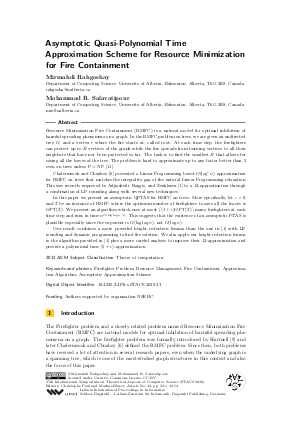Asymptotic Quasi-Polynomial Time Approximation Scheme for Resource Minimization for Fire Containment
Authors Mirmahdi Rahgoshay, Mohammad R. Salavatipour
-
Part of:
Volume:
37th International Symposium on Theoretical Aspects of Computer Science (STACS 2020)
Part of: Series: Leibniz International Proceedings in Informatics (LIPIcs)
Part of: Conference: Symposium on Theoretical Aspects of Computer Science (STACS) - License:
 Creative Commons Attribution 3.0 Unported license
Creative Commons Attribution 3.0 Unported license
- Publication Date: 2020-03-04
File

PDF
LIPIcs.STACS.2020.33.pdf
- Filesize: 494 kB
- 14 pages
Document Identifiers
Subject Classification
ACM Subject Classification
- Theory of computation
Keywords
- Firefighter Problem
- Resource Management
- Fire Containment
- Approximation Algorithm
- Asymptotic Approximation Scheme
Metrics
- Access Statistics
-
Total Accesses (updated on a weekly basis)
0PDF Downloads0Metadata Views
Abstract
Resource Minimization Fire Containment (RMFC) is a natural model for optimal inhibition of harmful spreading phenomena on a graph. In the RMFC problem on trees, we are given an undirected tree G, and a vertex r where the fire starts at, called root. At each time step, the firefighters can protect up to B vertices of the graph while the fire spreads from burning vertices to all their neighbors that have not been protected so far. The task is to find the smallest B that allows for saving all the leaves of the tree. The problem is hard to approximate up to any factor better than 2 even on trees unless P = NP [King and MacGillivray, 2010]. Chalermsook and Chuzhoy [Chalermsook and Chuzhoy, 2010] presented a Linear Programming based O(log^* n) approximation for RMFC on trees that matches the integrality gap of the natural Linear Programming relaxation. This was recently improved by Adjiashvili, Baggio, and Zenklusen [Adjiashvili et al., 2017] to a 12-approximation through a combination of LP rounding along with several new techniques. In this paper we present an asymptotic QPTAS for RMFC on trees. More specifically, let ε>0, and ℐ be an instance of RMFC where the optimum number of firefighters to save all the leaves is OPT(ℐ). We present an algorithm which uses at most ⌈(1+ε)OPT(ℐ)⌉ many firefighters at each time step and runs in time n^O(log log n/ε). This suggests that the existence of an asymptotic PTAS is plausible especially since the exponent is O(log log n), not O(log n). Our result combines a more powerful height reduction lemma than the one in [Adjiashvili et al., 2017] with LP rounding and dynamic programming to find the solution. We also apply our height reduction lemma to the algorithm provided in [Adjiashvili et al., 2017] plus a more careful analysis to improve their 12-approximation and provide a polynomial time (5+ε)-approximation.
Cite As Get BibTex
Mirmahdi Rahgoshay and Mohammad R. Salavatipour. Asymptotic Quasi-Polynomial Time Approximation Scheme for Resource Minimization for Fire Containment. In 37th International Symposium on Theoretical Aspects of Computer Science (STACS 2020). Leibniz International Proceedings in Informatics (LIPIcs), Volume 154, pp. 33:1-33:14, Schloss Dagstuhl – Leibniz-Zentrum für Informatik (2020)
https://doi.org/10.4230/LIPIcs.STACS.2020.33
BibTex
@InProceedings{rahgoshay_et_al:LIPIcs.STACS.2020.33,
author = {Rahgoshay, Mirmahdi and Salavatipour, Mohammad R.},
title = {{Asymptotic Quasi-Polynomial Time Approximation Scheme for Resource Minimization for Fire Containment}},
booktitle = {37th International Symposium on Theoretical Aspects of Computer Science (STACS 2020)},
pages = {33:1--33:14},
series = {Leibniz International Proceedings in Informatics (LIPIcs)},
ISBN = {978-3-95977-140-5},
ISSN = {1868-8969},
year = {2020},
volume = {154},
editor = {Paul, Christophe and Bl\"{a}ser, Markus},
publisher = {Schloss Dagstuhl -- Leibniz-Zentrum f{\"u}r Informatik},
address = {Dagstuhl, Germany},
URL = {https://drops.dagstuhl.de/entities/document/10.4230/LIPIcs.STACS.2020.33},
URN = {urn:nbn:de:0030-drops-118946},
doi = {10.4230/LIPIcs.STACS.2020.33},
annote = {Keywords: Firefighter Problem, Resource Management, Fire Containment, Approximation Algorithm, Asymptotic Approximation Scheme}
}
Author Details
- Department of Computing Science, University of Alberta, Edmonton, Alberta, T6G 2E8, Canada
Funding
Authors supported by organization NSERC.
References
- David Adjiashvili, Andrea Baggio, and Rico Zenklusen. Firefighting on trees beyond integrality gaps. In Proceedings of the Twenty-Eighth Annual ACM-SIAM Symposium on Discrete Algorithms, SODA '17, pages 2364-2383, Philadelphia, PA, USA, 2017. Society for Industrial and Applied Mathematics. URL: http://dl.acm.org/citation.cfm?id=3039686.3039842.
-
E. Anshelevich, D. Chakrabarty, A. Hate, and C. Swamy. Approximability of the firefighter problem. In Algorithmica, pages 520-536, 2012.

-
L. Cai, E. Verbin, and L. Yang. Firefighting on trees:(1 - 1/e)–approximation, fixed parameter tractability and a subexponential algorithm. In Proceedings of the 19th International Symposium on Algorithms and Computation, ISAAC '08, pages 258-269. Springer-Verlag, 2008.

-
G. Calinescu, C. Chekuri, M. Pal, and J. Vondrak. Maximizing a monotone submodular function subject to a matroid constraint. In SIAM Journal on Computing, pages 1740-1766, 2011.

-
P. Chalermsook and D. Vaz. New integrality gap results for the firefighters problem on trees. In Approximation and Online Algorithms, Cham, Springer International Publishing, pages 65-77, 2017.

- Parinya Chalermsook and Julia Chuzhoy. Resource minimization for fire containment. In Proceedings of the Twenty-first Annual ACM-SIAM Symposium on Discrete Algorithms, SODA '10, pages 1334-1349, Philadelphia, PA, USA, 2010. Society for Industrial and Applied Mathematics. URL: http://dl.acm.org/citation.cfm?id=1873601.1873709.
-
S. Finbo, A. King, G. MacGillivray, and R. Rizzi. The firefighter problem for graphs of maximum degree three. In Discrete Mathematics, pages 2094-2105, 2007.

-
B. Hartnell and Q. Li. Firefighting on trees: how bad is the greedy algorithm? In Proceedings of Congressus Numerantium, pages 187-192, 2000.

-
B.L. Hartnell. Firefighter! an application of domination. In 24th Manitoba Conference on Combinatorial Mathematics and Computing, 1995.

-
Y. Iwaikawa, N. Kamiyama, and T. Matsui. Improved approximation algorithms for firefighter problem on trees. In IEICE Transactions on Information and Systems, pages 196-199, 2011.

-
A. King and G. MacGillivray. The firefighter problem for cubic graphs. In Discrete Mathematics, pages 614-621, 2010.

- Euiwoong Lee. Improved hardness for cut, interdiction, and firefighter problems. In 44th International Colloquium on Automata, Languages, and Programming, ICALP 2017, July 10-14, 2017, Warsaw, Poland, pages 92:1-92:14, 2017. URL: https://doi.org/10.4230/LIPIcs.ICALP.2017.92.
-
J. Vondrak. Optimal approximation for the submodular welfare problem in the value oracle model. In Proceedings of the 40th Annual ACM Symposium on Theory of Computing (STOC), pages 67-74, 2008.

